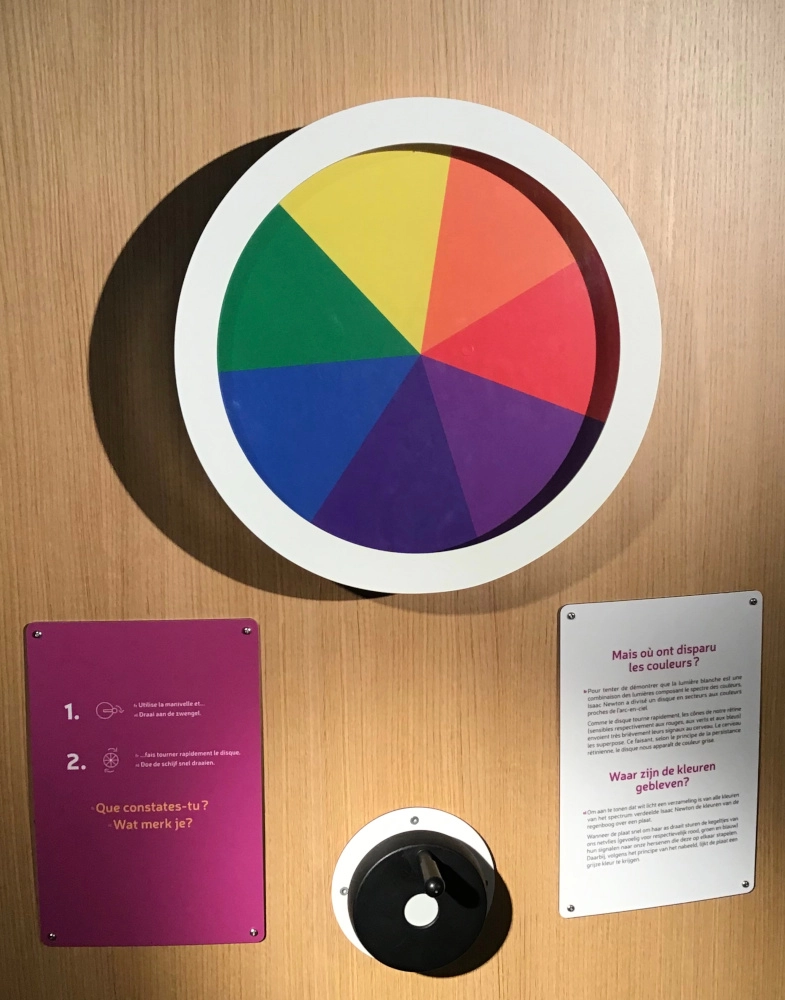
A Houtopia, you'll be bug-eyed
Do you know the Newton's disc
Newton’s disk is a disk composed of sectors in the colours of the rainbow. It appears white to us when it spins at full speed. This experiment allows you to understand important principles of sight: retinal persistence and colour fusion.


Where are the colours ?
In an attempt to demonstrate that white light is a combination of the lights making up the colour spectrum, Isaac Newton divided a disc into sectors with colours close to the rainbow.
As the disc rotates rapidly, the cones of our retina (sensitive to reds, greens and blues respectively) send their signals to the brain very briefly. The brain superimposes them. In this way, the disc appears grey in colour, according to the principle of retinal persistence.

White light
White light is the addition of all the colours of the rainbow. If you break this light down with a prism, you will find the colours of the rainbow again.
The experiment of coloured light

A luminous projection of the 3 primary colours (red, blue, green) on you will allow you to observe the decomposition of light and to become aware of your body by observing the play of shadows that are created. This experience also allows you to compare the luminous primary colours and the material primary colours.
Addition or subtraction?
Additive synthesis occurs by superimposing coloured lights. By superimposing two of the primary colours (red-green-blue), we obtain the complementary colours (yellow-cyan-magenta). By superimposing the three primaries, we obtain white light. The complementary colours are lighter and absorb less light, hence the name additive synthesis.
In painting, or in printing, we speak of subtractive synthesis, which is achieved by mixing coloured pigments rather than light. By mixing two of the primary colours (cyan-yellow-magenta), we obtain the complementary ones (green-red-blue) and by mixing the three primaries, an almost black colour. The complements are darker, they absorb more light, hence the term subtractive synthesis.
Illusion of distraction
During this experiment, you will watch a video sequence where the objective will be to follow a stone with your eyes, with the underlying question “where is the stone? ». At the end of the sequence, you will be asked another question… Have you seen anything else? You will be surprised to find that our sight is limited and you will become aware of your peripheral vision.

Have you seen it?
Il peut nous arriver de ne pas remarquer un phénomène visuel pourtant parfaitement présent. cette incapacité à détecter les phénomènes se produit généralement quand le stimulus est inattendu, ou parce que trop d’éléments attirent déjà notre attention, ou encore quand nous exécutons une action routinière.
Cette cécité ou cet aveuglement lié à notre distraction, est utilisée de façon amusante dans les tours de magie pour nous surprendre. Cette absence de visibilité peut aussi avoir de grave conséquences. Par exemple, si tu roules à vélo en lisant tes messages, ou si tu marches en passant une communication téléphonique, tu es moins attentif à ce qui t’entoure, et les risques d’accidents augmentent.
Want to know more ?
Listen to us on your favorite radio!




